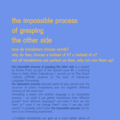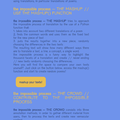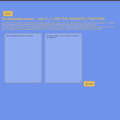User:FLEM/Final presentation: Difference between revisions
No edit summary |
No edit summary |
||
| Line 14: | Line 14: | ||
see the website: https://hub.xpub.nl/soupboat/theimpossibleprocess/ | see the website: https://hub.xpub.nl/soupboat/theimpossibleprocess/ | ||
=== Connection with second year project | === Connection with second year project === | ||
In the SI16, I analysed patterns and disrupted common structures to create new versions of texts. I created a prototype of linguistic patterns and the impossible project website, a tool for vernacular translations. Plus, I used the annotation system created for Special Issue 16 to gather translations from users. The final publication for the public to interact and understand the Python function I created has been the "letter bag", an activity that would reproduce what happens in the function and ask the user to do it by hand. In recalls what I am making in the Second Year project with the following question: what happens when you mirror digital interactions into a physical movement? In both cases, I reckon, it is a very interesting tool to make people who know nothing about coding, what is happening. | In the SI16, I analysed patterns and disrupted common structures to create new versions of texts. I created a prototype of linguistic patterns and the impossible project website, a tool for vernacular translations. Plus, I used the annotation system created for Special Issue 16 to gather translations from users. The final publication for the public to interact and understand the Python function I created has been the "letter bag", an activity that would reproduce what happens in the function and ask the user to do it by hand. In recalls what I am making in the Second Year project with the following question: what happens when you mirror digital interactions into a physical movement? In both cases, I reckon, it is a very interesting tool to make people who know nothing about coding, what is happening. | ||
=== Contribution/groups | I started to understand how python scripts work and started making some website to try out things. | ||
=== Contribution/groups === | |||
* I was part of ADMIN TEAM: creating the meetings, schedules, keeping track of the work. | * I was part of ADMIN TEAM: creating the meetings, schedules, keeping track of the work. | ||
| Line 24: | Line 26: | ||
* Content group: research on python function, set up, layout and flask for website of “the impossible process”; prints and booklet for the same project. In addition, general research for the “vernacular maps” group. | * Content group: research on python function, set up, layout and flask for website of “the impossible process”; prints and booklet for the same project. In addition, general research for the “vernacular maps” group. | ||
=== Side things | === Side things === | ||
* [[collabweek3]] | |||
* [https://hub.xpub.nl/soupboat/~flem/what%20happened%20to%20my%20dog%20last%20night/ Station Skill html] | |||
* [https://hub.xpub.nl/soupboat/~kamo/static/html/weaving/ text waving] | |||
* [[transcription]] | |||
* [[smart textile station skill]] | |||
* [[wood station skill]] | |||
* [https://hub.xpub.nl/soupboat/~flem/jacques%20prevert%20poems/ jacques prévert poems] | |||
* [[User:FLEM/The rejected side]] | |||
=== Gallery: === | === Gallery: === | ||
<gallery> | <gallery> | ||
File:SI16 annotation compass (1).png | |||
File:The impossible process (1).png | File:The impossible process (1).png | ||
File:The impossible process (2).png | File:The impossible process (2).png | ||
| Line 38: | Line 51: | ||
File:Presentation for paperbag.jpg | File:Presentation for paperbag.jpg | ||
File:Presentation for paperbag2.jpg | File:Presentation for paperbag2.jpg | ||
File:SI16 the mashup function explained.jpg | |||
File:SI16 LAUNCH varia map for proposal (2).jpg | |||
File:IMG 4820.jpg | |||
File:IMG 4843.jpg | |||
</gallery> | </gallery> | ||
Revision as of 10:32, 8 June 2023
Special issue 16
My main project during the special issue 16 was the poems translations.
the impossible process of grasping the other side
the impossible process of grasping the other side is a project by Emma Prato, as part of the Special Issue 16 //Learning How to Walk While Catwalking// carried out by Piet Zwart Institute (XPUB) students on the topic of Vernacular Language Processing.
the impossible process basically wants to play around with the structure of poetry translations and mix together different versions of the same text.
translating a poem into another language is an impossible process - so what if we gather translations from different people? from different languages? and what if then we mix them up? what if we change them? what if we play with words? it probably won't solve the impossible process but for sure is an interesting experiment.
//multiple translations can give us a much better sense of the poem than a single translation can, so that even if we can’t read the poem in the original language, we can come closer to that experience° // the impossible process is made of two sections: one (THE CROWD) is to gather //vernacular// information and the other (THE MASHUP) is to process texts, which can be both taken from the vernacular content or from already existing translations. The poetry archive (work in progress) will showcase the results.
see the website: https://hub.xpub.nl/soupboat/theimpossibleprocess/
Connection with second year project
In the SI16, I analysed patterns and disrupted common structures to create new versions of texts. I created a prototype of linguistic patterns and the impossible project website, a tool for vernacular translations. Plus, I used the annotation system created for Special Issue 16 to gather translations from users. The final publication for the public to interact and understand the Python function I created has been the "letter bag", an activity that would reproduce what happens in the function and ask the user to do it by hand. In recalls what I am making in the Second Year project with the following question: what happens when you mirror digital interactions into a physical movement? In both cases, I reckon, it is a very interesting tool to make people who know nothing about coding, what is happening.
I started to understand how python scripts work and started making some website to try out things.
Contribution/groups
- I was part of ADMIN TEAM: creating the meetings, schedules, keeping track of the work.
- I was part of LAUNCH TEAM: event coordination, organisation and user experience for the launch day.
- I was part of FRONT-END TEAM: support during the creation of front-end of the website, advices and considerations.
- Content group: research on python function, set up, layout and flask for website of “the impossible process”; prints and booklet for the same project. In addition, general research for the “vernacular maps” group.
Side things
- collabweek3
- Station Skill html
- text waving
- transcription
- smart textile station skill
- wood station skill
- jacques prévert poems
Gallery:
Special issue 17
Special issue 18
Second Year
final work: starting from the question on how can I edit and present all of this material I gathered in the last year. I wanted to share all the little discoveries I made and what I learnt with others. The choice of the cards come together with the consciousness of how hard it is for reader to follow such a long research and using my knowledge of notebooks structures and explorations to find a fitting solution. The notebook I created and experimented on myself in November 2022 (the notebook kit), provides a special feature "It has been helpful to re-organise thoughts in very small sheets of paper. This obliged me to describe a concept in a little amount of words". By dividing the concepts and information in small pieces and by transforming the medium into an interactive activity, that allows personalisation and modularity, i invite users of this publication-game to explore the concepts at their own pace. In addition, the concept of modularity participated widely also thanks to the concept of index cards: "Secondo Lancellotti (1583–1643) created an index system in which he would insert “associative cross-references and pointers whenever and wherever possible, enabling the reader to surf through” all these annotations, “replacing reading with a type of early modern hypertext” (Cevolini, 2020).
Write in the presentation that in the notebook book there are also information and discussions on how to write where to write and questions on how it makes a difference also the notetaking practice when approaching different interfaces















